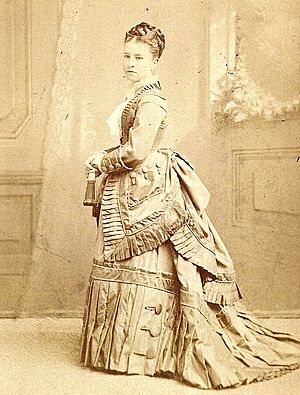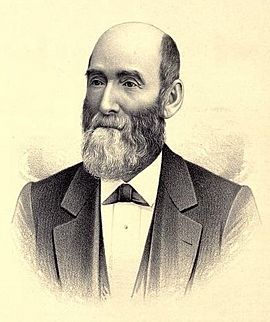Sallie Fox facts for kids
Quick facts for kids
Sallie Fox
|
|
|---|---|

Sallie Fox in her wedding dress, 1873
|
|
| Born |
Sarah Estelle Fox
1845 |
| Died | 7 February 1913 |
| Other names | Sarah Fox Allen |
| Known for | American pioneer |
| Spouse(s) | Oliver Perry Allen |
Sallie Fox (born Sarah Estelle Fox, 1845 – 1913) was a brave American pioneer. She was part of the Rose–Baley Party, one of the first groups to try traveling by wagon train from New Mexico to California using a new route called Beale's Wagon Road. Sallie was only 12 years old during this difficult journey.
Her story is told in the 1995 children's book Sallie Fox: The Story of a Pioneer Girl. A special apron she wore, which was damaged when she was hurt by an arrow during an attack in 1858, is now on display at the Vacaville Museum. This museum even has a special "Sallie Fox Day" each year to remember her.
Contents
Sallie's Early Life
Sallie Fox was born in 1845 in Southeastern Ohio. Her father, Aaron Moses Fox, was a farmer who passed away when Sallie was just a baby. Her mother, Mary Fox, then moved with Sallie and her older sister, Sophia, to Van Buren County, Iowa, to be closer to her family.
In Iowa, Mary married Alpha Brown, who also had two daughters. Together, Mary and Alpha had two more children, Julia and Orrin. In 1858, a rich businessman named Leonard John Rose decided to form a group to travel to California. He was excited by stories of California's "glorious climate, wealth of flowers and luscious fruits."
The Brown family, including Sallie, also wanted a new life in California. Mary's brother and sisters were already living there. Alpha Brown became the foreman, or leader, of Rose's wagon train. In April 1858, the family began their long journey west. Sallie Fox was 12 years old at the time.
The Rose–Baley Journey
In May 1858, near what is now Durham, Kansas, Rose's group joined another party led by Gillum Baley. They decided to travel together to California. By June, they reached Albuquerque, New Mexico without any problems. From there, they chose to use Beale's Wagon Road, which was a new and rough trail. This route crossed the Colorado River further north and could make their trip shorter.
In July, the group camped near Inscription Rock in New Mexico. Many people, including Sallie Fox, carved their names into the stone. Even today, you can still see their names there, though they are worn by time.
Attack at the Colorado River
On August 30, as the pioneers were getting ready to cross the Colorado River into California, they were attacked by Mohave Indians. Sallie Fox saw them coming and bravely shouted a warning: "The Indians are coming and are going to kill us!"
Her screams, along with war cries and gunshots, brought Alpha Brown and the other men quickly. Mary Brown quickly put a feather bed against their wagon and hid the children behind it, covering them with blankets. During the fight, Alpha Brown was killed. Sallie was badly hurt when an arrow went through the wagon and hit her side.
The Mohave were eventually driven away. Sadly, eight pioneers died, including five children from another family, and twelve were badly wounded. Alpha Brown's body was placed in the Colorado River. Because they had lost most of their animals and feared more attacks, the survivors had to leave almost all their wagons behind. They then had to walk 500 miles back through the desert to Albuquerque. Most of the survivors, including the wounded, walked the entire way.
The Difficult Journey Back
Sallie Fox later wrote about the hard trip back to Albuquerque: "All that my suddenly bereaved mother took for herself and five children she put into a flour sack, and we literally had to go to bed when our clothes were washed. Mother cut the skirts of our one dress apiece very short so as to make us each bonnets out of the extra length. We slowly wended our way back towards civilization, fearful every moment of another attack from the dreaded Indians, and suffering from the distressing heat and lack of water and food. My invalid sister and I hourly expected to die, so weak and feeble was she, and I, too, from my wound."
Despite the extreme difficulties, most of the group made it back to Albuquerque. They were helped by two other wagon trains they met along the way. These groups shared their food and turned back to help the survivors reach Albuquerque. Sallie's mother, Mary, carried her youngest child, Orrin, on their only remaining horse. When the horse died, she walked, carrying Orrin in her arms. Sadly, Orrin became ill and passed away just before they reached Albuquerque in November 1858. He was buried in an unmarked grave outside the town.
Sallie's wound slowly healed, but she had a dangerous time with a high fever. In January 1859, Edward Smith, one of the men who helped them, formed a new wagon train. He took Mary Brown and her four remaining children to California. This time, they took a different route along the Gila River.
Life in California

Edward O. Smith's group finally reached California at Fort Yuma. Local shopkeepers there gave Sallie and her sisters new clothes for free. The group then traveled to Los Angeles, arriving in the spring of 1859. Mary Brown and her children were the first members of the original Rose-Baley party to finally reach California.
Mary's brother, George Baldwin, met them in Los Angeles and took them to Vacaville. They stayed with Mary's sister Julia and her husband Josiah Allison for a while. Sallie's older sister, Sophia, stayed with the Allisons. Sallie went to Placerville to live with her mother's other sister, Lavinia, and her husband. Mary Brown also went to Placerville and later married for a third time to Judge James Johnson.
As a young woman, Sallie Fox became a teacher. She taught in elementary schools in the California Gold Country. In the late 1860s, Sallie moved to San Francisco with her aunt and uncle. She earned her State Educational Diploma in 1869 and began teaching at the Union Grammar School in San Francisco. To earn extra money, she also hand-colored photographs and sold her oil paintings.
In 1870, Sallie visited her childhood home in Keosauqua, Iowa. She brought the dress she wore during the Indian attack, which still had the arrow hole. When she showed the dress to schoolchildren and told her story, one boy asked if she had survived being shot.
After returning to California, Sallie became engaged to Oliver Perry Allen. He was a former naval officer and a veteran of the Mexican–American War who later worked in banking. They married in San Francisco on August 17, 1873. They had three children: a son named Edward (after Edward O. Smith), a daughter named Edith, and another daughter named Julia who died as a baby. Oliver Allen passed away in 1901.
In 1913, Sarah Fox Allen, as she was known later in life, died at age 67 in Napa, California. Her funeral was held at her family home in Oakland. Her half-sister, Julia Brown Foster, passed away in 1927. She is believed to have been the last surviving member of the Rose–Baley Party.
Sallie Fox's Legacy
Sallie Fox's story lives on. The 1995 children's book Sallie Fox: The Story of a Pioneer Girl by Dorothy Kupcha Leland tells a slightly fictionalized version of her family's journey. This book is even recommended by the California Department of Education for elementary school children.
When Sallie first arrived at her aunt and uncle's ranch in Vacaville, she planted four walnuts. She had collected these walnuts along the Gila River during her journey with Edward Smith's wagon train. One of them grew into a giant tree, which became a famous local landmark. This tree gave its name to Vacaville's Nut Tree Restaurant, Nut Tree Airport, and Nut Tree Railroad. Although the original tree was destroyed by a storm in 1952, other trees grown from its walnuts still stand there today.
The dress Sallie wore when she was injured by the Mohave arrow is displayed in the Vacaville Museum. The museum also holds an annual "Sallie Fox Day" to celebrate her life and courage.
Much of what we know about Sallie Fox comes from the papers of her daughter, Edith Allen Milner. Edith collected and wrote down her mother's memories. These writings, along with Sallie Fox's own description of her journey, are kept in the library of the California Historical Society. Other important information comes from Joseph Warren Cheney's "The Story of An Emigrant Train" and John Udell's diary, both published long ago.

